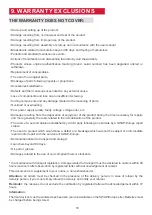
7
e.
Do not attach a saw chain woodcarving blade or toothed saw blade.
Such blades
create frequent kickback and loss of control.
Additional safety instructions for sanding operations
Safety Warnings Specific for Sanding Operations:
a)
Do not use excessively oversized sanding disc paper. Follow manufacturers’
recommendations, when selecting sanding paper.
Larger sanding paper extending beyond
the sanding pad presents a laceration hazard and may cause snagging, tearing of the disc or
kickback.
Warning symbol
WARNING - To reduce the risk of injury, user must read instruction manual.
Always wear ear protection
Always wear goggles
Always wear a breathing mask
In accordance with essential applicable safety standards of European directives
Class II product
Residual risks
Even if you use this product in accordance with all safety requirements, the potential risks of
injury and damage remain. The following risks may arise in the structure and design of this
product. Always be vigilant when using this product, so you can recognize and manage the
risks rather.
There are harmful health consequences resulting from the emission of vibrations if the product
is used for long periods or is not properly managed and properly maintained.
There is a risk of injury about the emission of dust and potential debris.
Risk of injuries to persons and their property due to flying objects
Harmful/toxic dust can arise from sanding (e.g. lead painted surfaces, woods, etc.). Contact
with or inhalation of these dusts can endanger the health of operator and bystanders. When
using this tool, always wear personal protective equipment, specifically a dust mask protection.
When operating the tool, take a position where you will not be in contact with these dusts.
Intended use
The drywall sander is designed for sanding walls and ceilings made of drywall or plaster. The


















